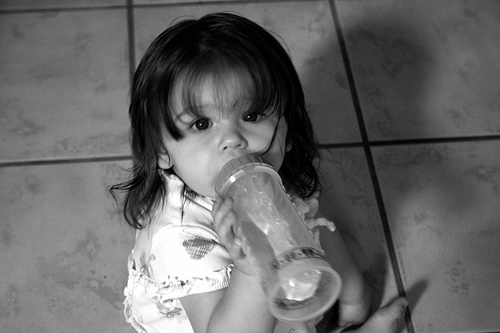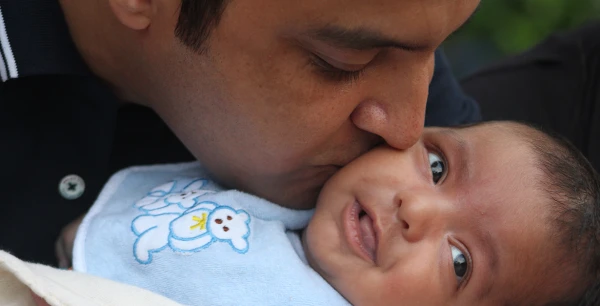Tough as it might seem to say bye-bye to the bottle for both of you (it comforts him, it makes things easy for you), it’s important to start the process sometime after your child’s first birthday, with the goal of having him completely weaned by 15 months.
Why You Should Wean Your Child From the Bottle
Toddlers are more likely to get attached to things between 15 and 18 months. They swing back and forth between flouting their independence and clinging to you. A child this age can now explore at a short distance from mom or dad, but there are times when he’ll want to stay nearby, especially if he’s tired, sick, or scared. And not only will he seek the safety of your lap, he may hang on for dear life to a familiar and comforting object—like his bottle, if he hasn’t already given it up. A toddler who’s still attached to a bottle will only latch on tighter if he’s allowed to have it as a source of comfort during this critical period. It’s better to encourage other attachments, such as a blanket, stuffed animal, or toy.
His budding pearly whites are at stake. This is especially true if you let your child walk around with his bottle, drink from it between meals and snacks, or have it at bedtime without brushing his teeth before he nods off: Healthy as it is, milk is full of sugars that can cling to budding teeth and cause decay (which can ultimately affect adult teeth as well). It’s even worse if he’s drinking juice from a bottle. You might as well hand him a box of cookies to snack on all day long! Giving a bottle to a toddler at bedtime and letting him fall asleep before you brush his teeth is an invitation to decay: I’ve worked with many families whose children have developed cavities as young as 18 months because they consistently went to sleep with milk on their teeth; likewise, I’ve seen kids as old as 5 with cavities for the same reason: They were still taking a bottle before bed.
It’ll ruin his appetite. Many children over 12 months will fill up on milk if they take it from a bottle. For example, toddlers who’re used to sucking down a 6- or 8-ounce bottle first thing in the morning aren’t likely to eat much breakfast. But at this age, they need other foods besides milk to be nourished. Kids can also literally drink faster from a bottle than from a sippy cup, making it even easier to fill up. (If you’re worried that without a bottle your child isn’t getting enough calcium, ask your doctor or visit this page on the American Academy of Pediatrics for age-by-age calcium requirements, and other good sources of it.)
A bottle can be an unnecessary crutch at bedtime. A primary rule of encouraging healthy sleep habits bears repeating: It’s vital to teach your baby to drop off by himself, without needing to nurse, say, or be rocked—and you certainly don’t want him to rely on sucking on a bottle in order to get to sleep. Besides that, by a year a child should be able to sleep through the night easily without needing to “top off” his belly.
How to Wean Your Toddler From the Bottle
1. Introduce a cup, if you haven’t already.
Ideally, you’ll have been giving your baby sips of milk from a cup by 6 to 9 months, but if not, start giving him different kinds until you find one he likes. (Some kids take to sippy cups right away, others prefer flip-up straws; some don’t care what kind of cup it is as long as it’s blue, or green, or has puppies or princesses on it.)
2. Eliminate the bottle, starting with lunch, the meal at which the bottle is probably least important to him.
Instead, serve his milk in his now-favorite cup.
3. Take away the dinner bottle—once he’s used to having a cup at lunch, after around four to seven days (follow his cues).
4. Next tackle the morning bottle.
Instead of handing your toddler a bottle as soon as he gets up, go right to the table for breakfast.
5. Finally, let the bedtime bottle go.
As long as your child has had a good dinner (which is not as much food as you might think), he doesn’t need extra milk to make it through the night. You may even be able to just skip the bottle at this point, since he’s gotten used to doing without it during the day, but if he puts up a fuss, take a graduated approach: Begin to reduce the amount of milk in the bedtime bottle by at least two ounces every two days. When you reach the three-ounce mark, offer a cup of water instead of a bottle during his bedtime routine (reading, singing, cuddling). If you’re convinced that your baby has to have milk before bed, then work toward serving that milk in a cup, and brushing his teeth before he goes to sleep.
Note: As soon as your baby is weaned from the bottle, throw away every single one in the house (even the spares you keep tucked in the diaper bag and car). You don’t want your child to discover a left-over bottle and demand a fill-up (it can happen months later!), nor do you want to turn to a bottle out of desperation to calm a tantrum or get a baby to go back to sleep at 4 a.m.
Oops! Is your child too attached to the bottle?
Let’s say you missed the 15-month mark and suspect your older toddler (or preschooler!) has developed an emotional attachment to his bottle.
Here’s how you can tell:
- His bottle is clearly his security object, or lovey.
- He wants it when he’s tired, overstimulated, or anxious, and may even whine or throw a tantrum in order to get it.
- He demands a certain beverage in it, and a certain amount.
- He needs it to fall asleep.
- He carries it around during the day.
To help a child who fits this description break his bottle habit, follow these steps:
1. Give him fair warning.
Let him know three to five days in advance that it’s about time to give up his bottle. Tell him everyday, at least twice a day, but pick a time when he’s not tired or about to go to sleep. Be calm, caring, confident, and positive.
2. During the period leading up to D-day, start minimizing the number of bottles he has during the day and reducing the amount of liquid in each.
Some parents like to restrict the bottle to naptime and bedtime, or allow it only in certain rooms. When he’s in a bottle “mood,” distract him with a game or offer him another form of comfort.
3. Also beforehand, gather up any bottles that are scattered around the house (your child might like to help you do this), and stop stockpiling pre-filled bottles in the fridge.
4. Some parents like to tell stories about giving the bottles away to babies in the hospital, the recycling center, the Easter bunny (if the timing is right).
That’s okay, but you still owe it to your child to tell him in advance.
5. On the big day, “officially” get all the bottles out of the house.
Tell your child what you’re doing, and remind him that you’ve been talking about this for several days. Stay firm, and don’t waiver—even if he whines or throws a fit—but at the same time be comforting and encouraging.
6. Offer a special reward or treat.
7. Don’t be surprised if all goes well for a few days, and then your child hits a rough patch and begs for a bottle.
Gently remind him that there aren’t any more bottles, and offer a kiss and a cuddle instead.
Was this article helpful to you? Please tell us by commenting below! For more baby, toddler, and family sleep tips and tricks, please subscribe to The Sleep Lady’s Facebook, Twitter, Pinterest, Google+, and YouTube channel! If you are looking for more sleep content, please check out Get Sleep Now-an exclusive members-only area designed to provide in-depth help and support during your sleep coaching experience.




